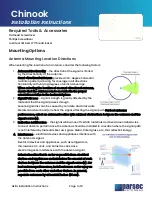
3 / 26
Selecting the Installation Site
It is essential to select the correct installation site. This determines whether your parabolic antenna can be erected safely and per-
form to its optimum capabilities.
When selecting the installation site, take account of special features of the structure of the building. If the installation is at the edge
of the roof or the building or on a cylindrical structure, DIN 1055, parts 4 and 4131 specifi es the increased wind and vibration loadings
that should be allowed for. The dynamic properties of the antenna and the structure can mutually infl uence each other and cause
detrimental changes.
When installing (e.g. under eaves), due to the off set angle of the antenna, there must be a clear view to the satellite at an angle of
approx. 60° above the top edge of the refl ector in relation to the horizontal.
Disregarding these considerations can lead to the maximum load or vibration fatigue stress listed in the Technical Data being excee-
ded.
The parabolic antenna need not necessarily be mounted on the roof
, since the requirement is not height as such but an
unobstructed “view” of the satellite. For this reason, an appropriate installation site might also be found for instance in the garden, on
the terrace, on the face of the building or on a garage.
In fact if other sites are possible, it is better to avoid the roof.
This will result in less work for you and will reduce the hazards asso-
ciated with installation work on the roof!
●
For good reception, an unobstructed “view” to the south
(±20°) must be ensured, at an elevation of about 30°. The fol-
lowing satellites are then available for selection:
1 TÜRKSAT
*)
42° East
6 EUTELSAT
HOTBIRD
13° East
2 ASTRA 2 group
*)
28.2° East 7 EUTELSAT W 1
10° East
3 ASTRA 3 group
23.5° East 8 HISPA-Sat
30° West
4 ASTRA 1 group
19.2° East
5 EUTELSAT W 2
16° East
●
Do make sure that there are no obstacles between the para-
bolic antenna and the respective satellite (such as trees,
roofs, house eaves or other antennas). Such items can impair
reception to the extent that during unfavourable stormy wea-
ther the signal is lost altogether.
*) The reception is dependent upon the respective location and the satel-
lite coverage zone
Installing the Antenna
When installing the antenna carrier (mast or wall boom), ensure
that it is standing upright. Otherwise, there may be problems
with the alignment of the antenna to the satellites.
a.
Requirements on the antenna carrier
– Use only masts or support tubes that are specially desig-
ned for installation of antennas. Other tubes generally do
not have the strength required to withstand the forces of
wind and weather.
– For mast installation, select a tube diameter between 48
and 90 mm, with a wall thickness at least 2 mm. For wall
installation, Kathrein recommends the use of ZAS 60 or
ZAS 61 wall supports.
– For mast installation on a roof, the mast must be clamped
for at least 1/6 of its free length (in the example bottom
right this is 0.7 m).
b.
Several antennas on a single antenna carrier
– Install the parabolic antenna as far down the mast as
possible, so as to minimise the bending moment at the
clamping point.
– Under no circumstances exceed the maximum value for
the loading on the mast or mast support, as stated in the
Technical Data. Suffi cient cognizance of the maximum
loading is achieved if you arrange your antenna system
as shown in example bottom right and use conventional
Ø 48 – 90 mm
West
South
East
Centre of the
reflector




































